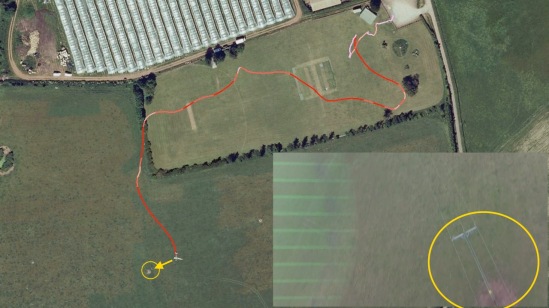Extract
The aim of this flight was to test the airframe and the electronics after the unplanned lawn dart into the mud. It was also the first test of the CRIUS CN-06 V2 U-blox GPS module. I didn’t bother to stream the video to the laptop. Instead I used the JuiceSSH app on my phone to access the Raspberry Pi and start a local 1080p HD and GPS recording.
Setup
The Crius GPS cable terminates in a standard 0.1″ pitch, four pin socket. The pin outs on the Raspberry Pi are spread out over five pins, so I borrowed a single socket housing from a PCB development jumper and re-arranged the connections as shown in the photo below.
The GPS was held on to the case with BluTak.
The only other change was to mount the camera on an extension so I could point it further down and to the right. The aim being to get the propeller out of shot.
I didn’t plan for any big tests on this flight so didn’t bother setting up the laptop. Instead I used the JuiceSSH app on my phone to start recording the GPS and video output on the Pi using a short script. As I wasn’t streaming the video, I bumped the resolution up to full 1080p.
#!/bin/sh cat $0 # Zero duration is continuous DURATION=0 WIDTH=1920 HEIGHT=1080 FRAMERATE=25 BITRATE=10000000 NOW=`date +%Y%m%d%H%M%S` FILENAME=$NOW-Pi.h264 gpxlogger -i 2 -f $NOW-Pi.gpx & /opt/vc/bin/raspivid -t $DURATION -w $WIDTH -h $HEIGHT -fps $FRAMERATE -b $BITRATE -n -o $FILENAME
The Flight
Almost immediately I felt something wasn’t working properly. Whilst the model was flying at normal speed, the climb rate was very low. The wind wasn’t as strong as previously, but there still seemed to be some significant turbulence tossing the plane around. After only one and a half circuits it started descending whilst over the far boundary and landed in a tree.
The only visible damage was a broken tailplane and a broken prop. I still had a WiFi connection from my phone to the Pi and was able to stop the recording and shut it down. I had a 4m long strap in the car with a heavy buckle on one end, but it wasn’t long enough to reach the plane. As this was lunchtime, I eventually had to leave it up the tree and return to work.
After work I stopped in at a local hardware store and bought 15m of chord and a pack of 10mm shackles. The plane was still up the tree when I got back to the field, so I tied two of the shackles chord and started launching it skywards. I soon found out I needed to tie some shackles to the loose end to stop the whole lot ending up in the tree. After about 10 minutes, I managed to get the chord over the fuselage and pull it free of the branches.
After disconnecting the battery, a more detailed examination revealed the only other damage as a dent in the nose. As the ESC had been connected for five hours, the battery had continued to drain and when checked was well past the minimum voltage. One of the cells was reading 2.15V, so that battery will be going for recycling.
Post-Mortem
I was able to extract the video and gps files from the SD card. It turns out the propeller was still partly visible in the video and because of this I could see the low voltage cutout had activated just as the plane crossed the far boundary. This is why it started descending and ended up in the tree. Why the battery went flat so quickly was another matter, as was the lack of power and the inability to climb.
Once I got everything on the bench I found the motor felt a bit rough. I can only assume that grit had got into the bearings after the mud bath. This could account for the increased current draw with the reduced power output.
Results
I think pointing the camera off to the side was a bad idea, even for a non FPV flight.
The one positive result was the CRIUS GPS. There was an excellent correlation between the video and the GPS track, as the two pictures below show.
Additional benefits for the CRIUS are:
- Doesn’t require a separate power supply as it doesn’t draw too much power from the Raspberry Pi.
- It’s a compact all-in-one unit.
- Freely available from eBay.
Conclusion
From now I shall be using the CRIUS GPS.
As the aircraft needs some rebuilding, I’m going to rework the internals so that I can mount the Raspberry Pi internally, with the camera above the nose. I also need to build a new power pod the will mount above the wing.
As an alternative platform for some actual First Person View flying, I’m also building a tricopter.





You must be logged in to post a comment.